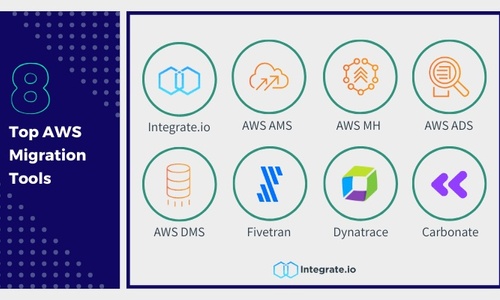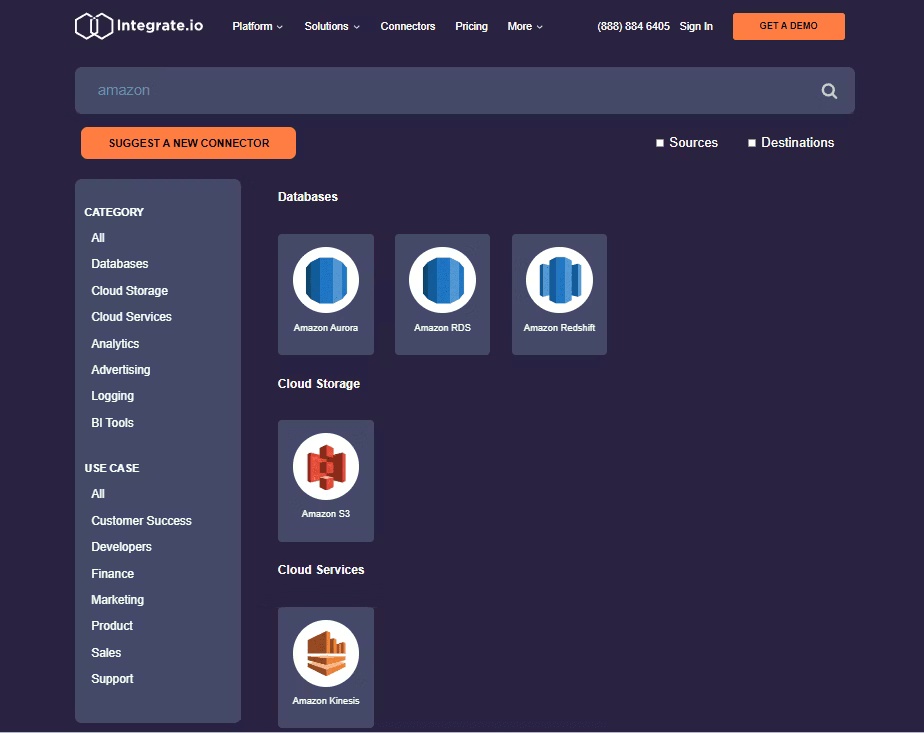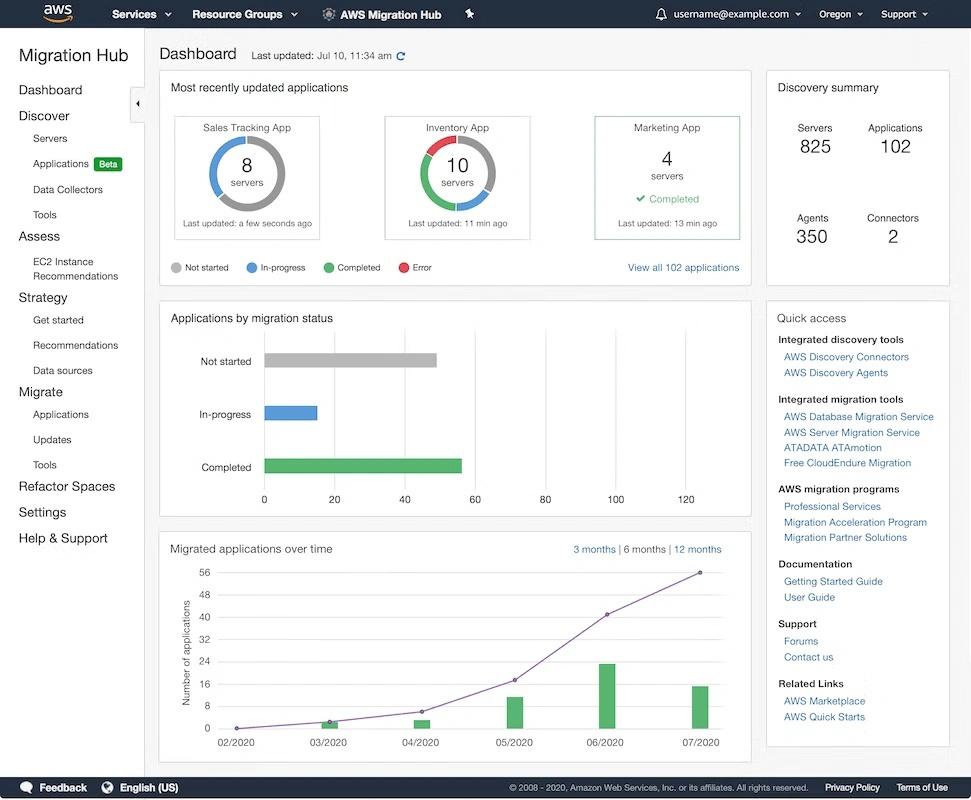Migrating to and from Amazon Web Services (AWS) is a common but tricky endeavor. Many moving parts and technical and security aspects need to be considered. AWS provides several of its own tools to simplify the migration process, but there are also several third-party products that can support the AWS migration process.
This guide will walk you through some of the best options on the market, their pros and cons, and what features may be useful for your particular migration project.
Before we take a closer look at individual AWS migration tools, here are the key things you should know:
- Several AWS migration tools are offered directly by AWS; however, several third-party solutions are just as capable.
- Many AWS migration tools have free versions or trial periods with enough utility to complete migration projects.
- Beyond simply migrating applications and workloads, AWS migration tools should support application modernization and refactoring for better results.
- Especially when working with legacy data sources, you should invest in an AWS migration tool that supports data discovery, cleansing, preparation, and other data quality management.
- Some of the top AWS migration tools include Integrate.io, AWS Application Migration Service, AWS Migration Hub, AWS Application Discovery Service, AWS Database Migration Service, Fivetran, Dynatrace, and Carbonite Migration.
What Are AWS Migration Tools?
AWS migration tools are applications and services that move data and workloads from on-premises or cloud environments into an AWS cloud environment. These tools may assist with a "lift and shift" approach, but most tools also automate or help with any data integration, transformation, and preparation tasks.
Depending on the tool you select, there may be different challenges or opportunities you'll face. For instance, some tools provide AI and automation features that simplify or eliminate hands-on tasks for administrators. On the other hand, these same features can complicate data and application security management.
Ultimately, users need to configure their AWS migration tools appropriately and consider any additional tools or integrations they may need for a successful migration.
How to Evaluate AWS Migration Tools
Here are the key things to consider when evaluating AWS migration tools.
Price
A wide range of price points are available for AWS migration tools and projects. Some tools and services, like AWS Application Migration Service, are free for a length of time that may be adequate to complete a migration.
What's most important is determining your budget ahead of time, identifying which workloads need to be migrated and predicting how long it will take, and then determining which AWS migration tool offers compatible resources and pricing.
Customer Support
Especially if your organization is migrating complex legacy applications or is otherwise unfamiliar with cloud migrations, you'll want to invest in tools with a strong customer support system.
Though 24/7 support availability may not be necessary for your project, your team should consider working with a vendor that offers both agent-driven and self-service support resources.
Integrations
Native integrations and low-code/no-code workflow builders are an easier route when connecting different environments for an AWS migration.
Particularly if you're considering a third-party migration tool, look for solutions that offer connectors for a wide variety of AWS applications and other data storage platforms.
1. Integrate.io
Rating: 4.3/5 (G2)
Key Features:
- Flexible data ingestion for hundreds of sources
- Low-code/no-code features for data aggregation, integration, and management
- ETL and reverse ETL
- External REST API capabilities
- Data extraction and staging for AWS platforms
Integrate.io is a cloud-based, no-code data pipeline platform that supports different data management and migration operations, including ETL, CDC, and data observability.
Its integration and connector library covers connections for a wide variety of business tools and applications, including Amazon Redshift, S3, Aurora, and RDS.
Integrate.io pricing/ is tailored exactly to each client's needs and requirements with a usage-based component couple with features and functionality. Clients choose which level of platform usage they will require and then which features and functionality to create a custom plan to fit their use case.
2. AWS Application Migration Service
Rating: No rating available
Key Features:
- Automated source server conversion into AWS-friendly format
- Built-in and custom optimization for applications
- Non-disruptive, pre-cutover testing
- Compatible with physical servers and most cloud servers
- Support for agentless replication
AWS Application Migration Service focuses on transforming users' source servers into a format that allows them to run natively on AWS cloud instances.
The service is one of the most common AWS migration solutions and can be used for a variety of use cases: projects that involve on-premises applications, cloud-based applications from other public clouds, workload movement between AWS regions, and application modernization.
This service is free for the first 90 days and costs $0.042 per server/hour after the free period ends. Most users complete their migration during the free period.
3. AWS Migration Hub
Rating: 4.5/5 (G2)
Key Features:
- Automated migration factory development
- Workflow templates for various public cloud and other third-party workflows
- Migration planning, tracking, and assessment support
- Server and application data collection for discovery and inventory
- Legacy application refactoring
AWS Migration Hub is another AWS-managed migration tool that serves as a planning space; it focuses on providing a centralized hub for users to collect and prepare their data and applications for migration.
The Hub can also be used post-migration for users who want to complete additional application modernization tasks. For most tasks, AWS Migration Hub is available for free up to 2,160 free environment hours per month for 90 days. After the 90 day period, the environment price increases to $0.028 per environment per hour.
4. AWS Application Discovery Service
Rating: 4.5/5 (G2)
Key Features:
- On-premises server inventory and infrastructure discovery
- Data collection for configuration, performance, and TCP
- Server dependency identification
- Performance baseline metrics
- Amazon Athena for data exploration on different servers
AWS Application Discovery Service is a useful solution for migrating to AWS from on-premises data centers. The service is used for data discovery on virtual and physical servers, agentless data collection, API connectivity, and manual imports. The tool also supports encrypted online transfer to protect on-premises workloads as they shift to the cloud.
AWS Application Discovery Service is a free service for migration planning. Users will only need to pay for any AWS resources they use for provisioning or final migration destinations.
5. AWS Database Migration Service
Rating: 4.1/5 (G2)
Key Features:
- Database and analytics system conversions and migrations
- Compatible with both commercial and open-source databases
- Low-code operations through the AWS Management Console
- Continuous replication and monitoring in the target destination
- Fully managed option through AWS DMS Fleet Advisor
AWS Database Migration Service (DMS) is a database migration solution that enables users to move databases of all sizes and in multiple formats to AWS databases. This tool offers many managed services and features, including Fleet Advisor and Schema Conversion, making it a leading option for organizations that require more guided assistance.
Pricing starts with the Free Tier, which includes up to 750 hours of Single-AZ access per month for one year.
6. Fivetran
Rating: 4.2/5 (G2)
Key Features:
- Automated data movement into various destinations
- Frequent syncs for streaming use cases
- Connectors for 10 different AWS and Amazon solutions
- Role-based access control
Fivetran is an automated data movement, ETL, and ELT platform that prioritizes diverse replication methods and offers both pre-built and custom connectors for Amazon products. Despite its size and affordability, Fivetran is still a strong solution for security and governance needs.
The product's free plan gives users access to up to 500,000 monthly active rows.
7. Dynatrace
Rating: 4.5/5 (G2)
Key Features:
- Smartscape for dependency, pattern, and usage mapping
- Before-and-after performance data
- Causal AI for troubleshooting
- Integrated automation engine for microservice discovery
- DevOps pipeline integration
Dynatrace is an analytics and automation platform that wins over enterprise customers with its detailed data mapping and visualization features as well as its practical integrations with business operations like DevOps.
Once you've used Dynatrace to support an AWS migration project, you can also use the product on an ongoing basis for automated and AI-powered monitoring and observability in AWS.
Pricing for Dynatrace is a la carte and will require users to assess which features are most important to them.
8. Carbonite Migrate
Rating: 5/5 (G2)
Key Features:
- Continuous, system, file, and data replication
- Automated cutover
- Unlimited new environment testing
- Full-server or data-only migrations
- Virtual-machine auto-provisioning
Carbonite Migrate is a cloud migration solution that's typically used by enterprise organizations that want more flexibility in their infrastructure and deployment options.
The tool also emphasizes little to no downtime and comprehensive testing both pre- and post-migration. Prospective buyers will need to contact Carbonite for pricing information.
AWS Migration Best Practices
For the best possible results, follow these AWS migration best practices.
#1. Define Your Migration Goals First
Before you begin moving data, applications, and workloads from one ecosystem to another, it's important to first set some clear and strategic migration goals.
These focus less on how you want to complete the migration and more on what you want to accomplish as the result of a successful migration. Some possible migration goals to consider include:
- Cost reduction or optimized resource utilization
- Improved security and compliance metrics
- Quicker and more scalable performance
- Less frequent periods of network downtime
#2. Identify All the Data & Assets You Must Migrate
Now that you've set overarching goals for your data migration project, it's time to map out all of the different resources that need to be lifted and shifted. Start by deciding what you want to move, then decide how data needs to be transformed or prepared for this transition.
Before going any further, you'll also want to determine if any security or compliance rules need to be followed and if any special roles or permissions need to be set for users.
#3. Migrate in Batches
Especially when moving large quantities of data and bigger applications, it's a good idea to migrate your content and tools in batches. This will allow you to periodically test the quality of your migrations and monitor for any specific issues that need to be addressed with the next batch.
Migrating in batches also helps to reduce the chances of slow load times or other errors that could impact network performance.
#4. Continue to Monitor After the Migration
After migration has been completed, it's important to monitor how migrated data and workloads perform in their new environment. Continual monitoring will allow you and your team to identify any performance or security issues as soon as they arise rather than once they've grown into bigger problems.
Complete AWS Data Migration With Ease With Integrate.io
Integrate.io is an easy-to-use tool with several Amazon connectors that make the migration process run smoothly. Integrate.io also offers native connectors for other relevant tools, like BI and CRM platforms, which makes it easier to derive meaningful insights from your data before, during, and after an AWS migration.
If a low-code/no-code solution that covers all the bases is what you're looking for in an AWS migration solution, get started with a 14-day free trial today.
AWS Migration Tools FAQs
What Tools Are Used for Migration in AWS?
Both third-party tools and AWS-owned tools are used for AWS migration. Examples of AWS tools used for migration include AWS Migration Hub, AWS Application Discovery Service, AWS Database Migration Service, and more.
What Are the Three Phases of AWS Migration?
The three phases of AWS migration are assess, mobilize, and migrate. Assess and mobilize focus on the movements and preparation work necessary to prepare for a migration, while migrate focuses on the actual work of migrating workloads into new environments.













